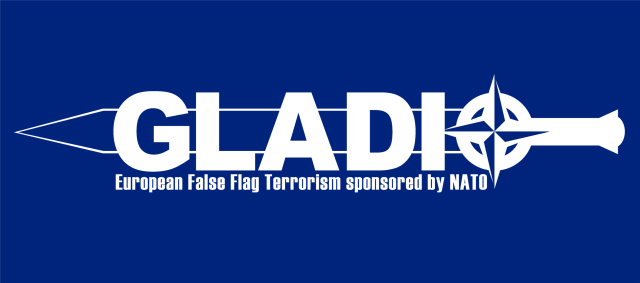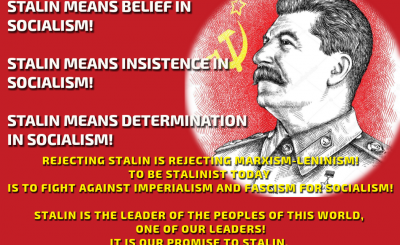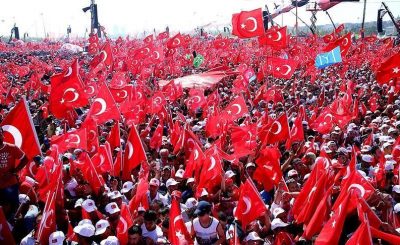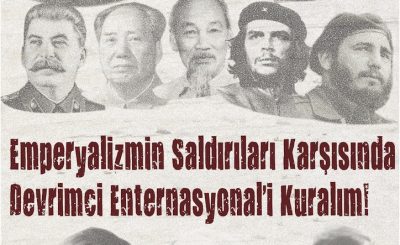Founding Of The Contra-Guerrilla In Turkey
At the beginning of the 1990s, the existence of contra-guerrilla organisations was revealed in the NATO countries and in countries like Finland and Sweden, which did not themselves belong to NATO. However, although Turkey is a NATO member,the existence of a contra-guerrilla organisation in Turkey has always been denied. Perhaps the European imperialist countries no longer have a need for contra-guerrilla organisations, but the Turkish oligarchy will have a need for it for a long time to come. It has never been possible here to put an end to the revolutionary and the national liberation struggle, on the contrary: the danger of a revolution has only become greater for the oligarchy.
Neither the oligarchy nor imperialism could live in peace with that. Therefore the fight against the people was stepped up, especially at the beginning of the 1990s, and more and more use of the contra-guerrillas was made. With disappearances, executions, massacres, coercing people to betray others,the burning down of villages, provocations, forced emigration and denunciations of revolutionaries and patriots, psychological warfare was increased, the activities of the contra-guerrillas were institutionalised and became state policy.
New organisations such as the Special Units and the secret service of the military, JITEM, were set up,contra-guerrilla traitors were employed and the “village guards” were legalised. Using such methods means waging war against the people. But these methods of war against the people are nothing new. They have been used before by the imperialists, especially by the USA and its contra-guerrilla centre, the CIA,in their war against the peoples all over the world.
When the USA began to enlarge and secure its capitalist world order after 1945, contra-guerrilla organisations were set up in all the countries in the world it could reach. The aim was not to protect these countries from the danger of “communist occupation”, they actually wanted to prevent national liberation struggles and revolutions in these countries, to bring collaborator governments in power and keep them there with the help of the contra-guerrilla organisations. In this way these countries were to be made dependent upon the USA, and transformed into a constant resource for exploitation. Therefore contra-guerrilla organisations were not only set up in the NATO countries, they were set up in all countries which collaborated with the USA.
The military experts Peter Paret and John W. Shy described the goal of the USA in this way: “The goal is to strengthen the authority of the governments which are supported by the USA, securing their regimes.” (P. Paret and J.W. Shy, Guerrillas in the 1960s, p. 42)
“The USA can and must deploy the contra-guerillas in crushing leftist or non-leftist governments which are not acting according to the wishes of the USA. […] It’s our goal to instal friendly governments instead of unfriendly governments which are not acting in accordance with our interests.” (ib. p.302)
To achieve these goals, the USA planned coups in many countries, carried them out themselves or supported those who did. The military coup of 1973 in Chile, for example, was planned by the financial director of the American monopoly ITT. The socialist president of Chile, Allende, who won elections democratically,was brought down and his place was taken by a military junta. In 1953, the CIA was involved in bringing down the government of Prime Minister Mossadeq in Iran. Feyzullah Zahidi, brought into power in his place by the CIA, had been a supporter of the Nazis. In Greece, the governments were controlled by contra-guerrillas. Vietnam, Korea and other countries where the USA waged open war, and Latin America, known as the “backyard of the USA”, served as a laboratory for the contra-guerrilla.
The contra-guerrilla in Turkey, strengthened in the 1980s and actually forming the government, have been waging an intensified war against the people since the 1990s, profiting from the experiences the CIA had made in previous years in these countries.
THE FIRST CONTRA-GUERRILLA CENTRE: THE “MOBILISATION WORKGROUP”
In 1947, the government of the CHP (Cumhuriyet Halk Partisi – Republican People’s Party) changed the system from a one-party system into a multi-party system, because of relations with the imperialist countries, especially the USA. This phase has been very important for Turkey. The relations with the USA rapidly developed under the government of the DP (Democratic Party), led by Prime Minister Adnan Menderes. In the general treaty with the USA and the European countries, Turkey asked for economic aid in particular.
Under the Marshall Plan, influenced by the Truman Doctrine, this aid was generously granted to bring the USA closer to its aim of world domination.Although there was no written request by the USA or a corresponding treaty, Turkey – on its own initiative – sent soldiers to Korea for the benefit of the imperialists in order to show itself a reliable friend of the USA. On April 4, 1952, Turkey became a member of NATO. Under the “Treaty for Mutual Defence”, Turkey signed many treaties which made it dependent of the imperialists. As in all other NATO countries, a contra-guerrilla organisation was set up in Turkey in 1952 against the “threat of a communist occupation”, and this was called “Mobilisation Workgroup”. And like in all founding member countries, the public and parliament were not informed about the existence of the contra-guerrillas. Only the few who took part in setting it up, knew about it.
The contra-guerrilla, under the command of the deputy chief of the general staff, was housed in the same building as the US aid-organisation JUSMAAT,in Ankara/Bahcelievler. In 1965, the name was changed to “Special Warfare Department”, and in 1990 it was renamed “Special Forces Command”. Until 1974, the CIA took care of all the costs and the training of the contra-guerrillas.
THE CONTRA-GUERRILLAS AND THE CIA ARE INTERWOVEN
Under the “Being of Help” programme, and through the mediation of the CIA, prospective contra-guerrillas were trained in schools or camps in the other imperialist countries or the colonies. Among the trainees were officers, policemen as well as civilians. They are trained by the USA, but not because the USA wants to be of help. In the training camps and schools, the CIA contacts them and tries to enlist them as CIA agents. It establishes an organisation of its own in all the contra-guerrilla countries. And thus it governs all the countries it wants to keep under its control through the contra-guerrillas. It works its way into the most remote corners of the state, getting information about politicians, about the latest developments, much quicker than those who are wielding official power. It tries to get the policemen and military officers – who have become its agents or who can easily be indoctrinated with its policy and even the bureaucrats and politicians – into key positions in state bodies. During the putsch and the military junta, these officers – who had become CIA agents – played a major role.In 1967, Secretary of Defence Robert McNamara explained US aims:
“To state it even more openly, with the aid for Latin America we pursue the aim, if necessary, to support the training of the military or paramilitaries to restore much-needed internal peace, together with the police and the other security forces.”
“The actual reason for our military aid for these countries, where the military is weakly developed, is to model them according to the ideology of the USA,to use them, if necessary, in the future in governing these countries.”
The war of the contra-guerrillas against the people also increased opposition. Forty-four years have passed since the contra-guerrillas were set up in Turkey. But in the last five years considerable differences have appeared, both in relation to the power it achieved in state bodies, as well as concerning the methods which are being used in the war against the people. Certainly this is no coincidence. When the oligarchy – through the contra-guerrillas – uses the most brutal and cruel methods in the war it has opened against the people, then this stems from its helplessness against the revolutionaries and the national struggle. In the past they saw all its tools and methods weren’t sufficient to stop the struggle, and now it’s forced to develop new methods and tools to continue the war.
Between 1950-1960 the US “policy of Cold War” was applied in a radical manner in Turkey by the Democratic Party, led by Menderes. “Communism and the Soviet Union” were supposed to be the biggest enemies. In this period, in 1955, the contra-guerrillas carried out its first operation: a bomb attack against the Ataturk House, a museum, in Thessalonika, Greece. The government and the pro-government press used this event to provoke the people. Fascists, organised by the provocations of the contra-guerrillas, carried out attacks against houses, shops and workplaces of Armenians and Greeks in Istanbul. These places were burned and destroyed.
But the bankruptcy of its economic policy caused an economic crisis and poverty in the country and the Democratic Party suffered setbacks. The contra-guerrillas increased their attacks against the opposition even more, eventually leading to growth in the democratic opposition and the coup of May 27, 1960. The USA knew about this coup beforehand, but it became clear they could not control the organising officers in the way they wanted. It’s true, the fascist Alparslan Turkes, trained in the USA, initially took part in the newly founded committee of national unity, but he and his friends were quickly removed and sent into exile. Later he became the leader of the civilian fascist movement the MHP (the Grey Wolves).
In the mid-1960s the mass actions started. In 1967, DISK (Revolutionary Trade Union Confederation) was founded and the organisation of the workers rapidly developed. From 1968 onward, the discussions among the left increased and the revisionist line of the TKP (Turkish Communist Party) and the TIP (Turkish Labour Party) was considered obsolete. Large parts of the youth disassociated themselves from this line. First the KFK (Debating Club Federation, led by Mahir Cayan) was founded, and later the Revolutionary Youth (Devrimci Genclik). The contra-guerrillas were more and more used against the growing and radicalising opposition which began to strive for revolution. A civilian organisation of the contra-guerrillas, the fascist MHP movement, began to organise in this period. From 1967 the civilian fascists were trained in the commando camps of the contra-guerrillas. Alparslan Turkes is the leader of this movement.Nihat Yazar, former chairman of the MHP disciplinary committee, who later left the party, reported in a statement to the paper Politika about the participation of Alparslan Turkes in the coup of 1960:
“The contacts between Alparslan Turkes, who was involved in the coup, and the CIA, began in those days.”
Against the growing people’s opposition, the state began to make use of the civil fascists, as well as the police and the military.
PROVOCATIVE ACTIONS BY THE CONTRA-GUERRILLA
Since the 1960s, provocative actions have been part of the methods of the contra-guerrilla to increase the impact of its psychological warfare. The March 12 coup and many sabotage actions were carried out. And attempts were made to make it look as if the revolutionaries were the perpetrators. A large-scale smear campaign was launched against the revolutionaries. Some of these actions are listed below:
- A red flag was hung from the Galata Tower in Istanbul.
- The Ataturk Cultural Palace in Taksim/Istanbul was burned.
- A ferry was sunk in Eminonu/Istanbul.
- A bomb attack against the Sirkeci Train Station in Istanbul.
- A bomb attack against the Ataturk Airport in Yasilkoy/Istanbul.
- The Marmara ferry was set on fire.
With such provocative actions,the contra-guerrillas used terror against the revolutionaries, democrats and intellectuals. Hundreds of people were arrested and tortured. But as always in these types of actions, the perpetrators were never found.
THE BEGINNING OF THE MASS EXECUTIONS
With the coup of March 12, 1971, the contra-guerrillas became even stronger. Unlike the coup on May 27, 1960, the contra-guerrillas played a major role. During the junta, the name of the contra-guerrillas could most be heard in Istanbul/Erenkoy, in the torture centre in the Ziverbey House. In this period the contra-guerrilla chief of the general staff was Memduh Tagmac.
Later the organisations of the contra-guerrillas, the fascist MHP, and the support bases of the fascists gained in strength. From 1974, when the revolutionary struggle began to increase, the attacks by civilian fascist gangs began anew. The fascist gangs wanted to control the schools, neighbourhoods and villages in the entire country. The oligarchy wanted to strangle the growing opposition by imposing a fascist occupation. This caused the masses, forced into the class struggle, to organise the anti-fascist struggle. Although several opportunistic and revisionist organisations behaved passively towards the fascist attacks, resistance was mounted in the schools and the neighbourhoods. Large sacrifices were made and thousands of revolutionaries and patriots fell. But the fascist plan was frustrated. The attempts by the fascists to seize places by force were largely disrupted in all parts of the country.
When the growing opposition could no longer be halted with the help of state-supported fascist attacks, the oligarchy had no other option left than to carry out a military coup. Between 1975-1980, most contra-actions were carried out by civilian fascists. In this period, revolutionaries and patriots were mostly kidnapped, tortured and murdered by organisations like ETKO (Salvation Army for the Imprisoned Turks, led by MHP-fascists) and the TIT (Turkish Revenge Brigade). The murdered people were put in sacks and dumped The contra-guerrillas carried out the most shocking and conspicuous mass executions in this period:
- May Day, 1977: people on the streets are shot at by snipers in buildings and crushed by tanks. The death of 36 people was a starting signal for a veritable wave of mass executions.
- March 16, 1978:In front of the University of Istanbul democratic
- and revolutionary students were shot when they left the university
- building. Later seven students are murdered in a bomb attack.
- October 8, 1978: seven students who were members of the TIP (Turkish Labour Party), were murdered in their houses in Ankara/Bahcelievler by fascists. Abdullah Catli was one of those responsible for this massacre.
- October 1978: Four students were taken from a bus by fascists in Istanbul and shot.
- December 21, 1978: Before the massacre in Kahramanmaras, two teachers, members of the TOB-DER (Teachers’ Union) were murdered. The next day, December 22, fascists attacked the people who attended the funeral ceremony for the murdered teachers. From there, the fascists marched to the shopping centre where they destroyed shops owned by Alevis, as well as the buildings of the CHP (Republican People’s Party).During a confrontation, three more people are murdered. On December 23, ostensibly to prevent a confrontation between police and the people, the policemen were called off the streets.This give the fascists the opportunity to gather, and they were given a free hand. Soldiers, summoned by the governor on December 21, never arrived. On December 24, the fascists attacked a neighbourhood predominantly inhabited by Alevis. They murdered children, elderly people, women – even pregnant women – and the sick. The massacre continued until the evening of December 25. Two hundred and ten houses and 70 workshops are destroyed and burned. As far as can be ascertained, 111 people were murdered.
- May 16, 1979: Fascists stormed a cafe in Ankara/Etlik Piyangotepe which was frequented by leftists. The people were forced to lie down and were then shot. Seven people were murdered.
- October 27, 1979: A cafe in Devrim Street in Istanbul/Bayram which was frequented by leftists was stormed by fascists.
- On October 28,1979:Another cafe, this time in Kayseri, was riddled with bullets by fascists: five people died.
- On December 16, 1979: the Barbados Coffee House in Istanbul/Besiktas, often frequented by revolutionary students, was bombed. Five students died in the attack.
(These are only a few examples, the list of massacres is almost endless)
Explosives depot in the house of a MHP contra-guerrilla.
On February 16, 1978, explosives were found of a retired army captain, Mehmet Ali Cevirker. It was determined that the explosives, used in the massacres of March 16, 1978 at the University of Istanbul and in Kahramanmaras, stemmed from Mehmet Ali Cevirker’s depot. In August, 1978, the fascist Ali Yurtaslan testified that Mehmet Ali Cevirker was a member of the MHP, having close contacts to the leadership of the fascist movement. MHP leaders ordered forged papers for Mehmet Cevirker in order to get him out of prison, but this was prevented.
ACTIONS BY THE CONTRA-GUERRILLA
The Cigli Airport in Izmir: assault against prominent politician Bulent Ecevit.
When Ecevit arrived at the airport, a policeman shot at him. However, the bullet hit the leg of Mehmet Isvan who was standing next to Ecevit. A second attack was planned at a meeting in Taksim/Istanbul, but this was prevented because of a warning from Suleyman Demirel.
“We weren’t even able to nationalise the council of ministers” (Inonu to Suleyman Genc during a visit on April 22, 1970)
The youth leader in 1970 decided to make a report about NATO, CENTO, oil, the national economy, the building industry, the nationalisation of natural resources and independence. This report was meant for the then Prime Minister Inonu. Suleyman Genc took this task upon himself.After Inonu read the report, he told Suleyman Genc:
“Let me tell you what happened to me once: I was prime minister in 1963. The situation on Cyprus was growing tense. The London-Zurich Treaty was unilaterally changed by the Cypriot state minister. I called for a meeting of the council of ministers and we discussed the necessary security measures. We decided on a policy we were going to implement. The meeting was concluded and my friends left. Forty-five minutes later the American consul phoned and asked for a meeting. He indicated he wanted to talk to me about the problems in Cyprus. I agreed. He listed all we had discussed during the meeting. `These are dangerous thoughts, these could lead to dangerous reactions. The Turkish government must not be the cause of such dangerous events,’ he told me. We weren’t even able to nationalise the council of ministers, so what do you think you can achieve?”
“I give an order, and before I even get the results, Washington knows about it”
During a meeting in 1964, Ismet Inonu reported how the CIA was organised in Turkey under the name of “advisers-experts”:
“We still want an independent policy, full of character. Everybody is talking about the same things. But how am I going to do this. I will decide and give the matter into the hands of experts. Can they do this? They are surrounded by foreign advisers, and it is all being delayed. And when this doesn’t help, they take security measures. I give an order, and before I even get the results, Washington knows about it. I do not get the results from my civil servants, I get them from the foreign advisers. Have we handed over the state like this? They never showed me a report which constituted a real solution. All was forbidden. All we do, we do it with our people. And so thousands of people just walk around, having certain abilities. And now these gangs are on the agenda. We could have resolved the tension between the two states ourselves. It’s all about the attack on our own powers of initiative. They were prepared to make a proposition if we agreed to accept even one of their experts. We didn’t agree. We knew perfectly why they wanted this. And they knew perfectly why we didn’t agree. That’s how things are.
promises, and when you sign, they arrive the next day. Then just you try to get rid of them again! They will not leave anymore. But we have to consider this seriously. Otherwise it’s impossible to conduct an independent foreign and domestic policy. Do not think it’s all that easy. Even unexpected events are better than this. If we tried to get rid of them, I don’t know what would happen to us.”




